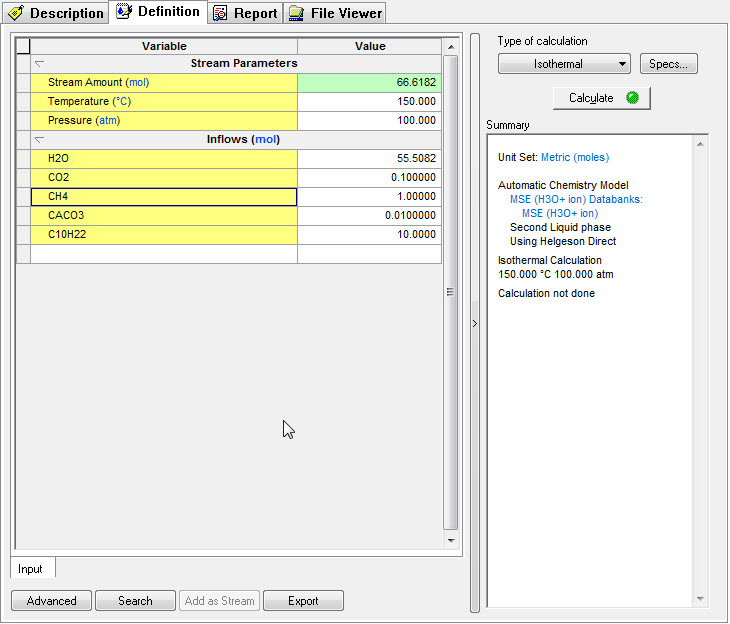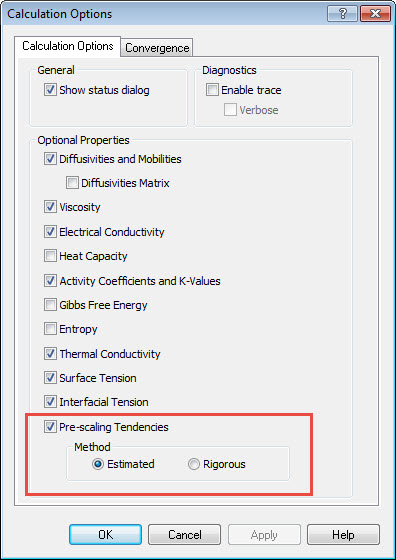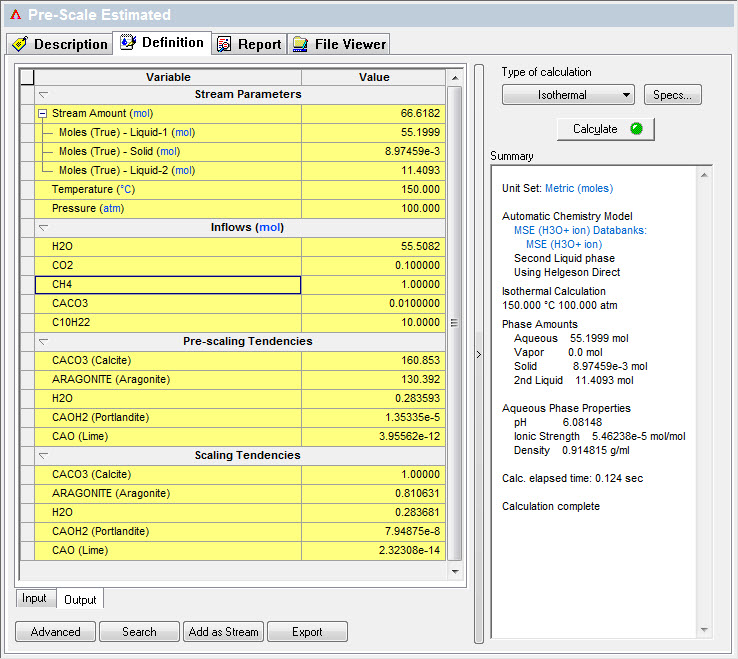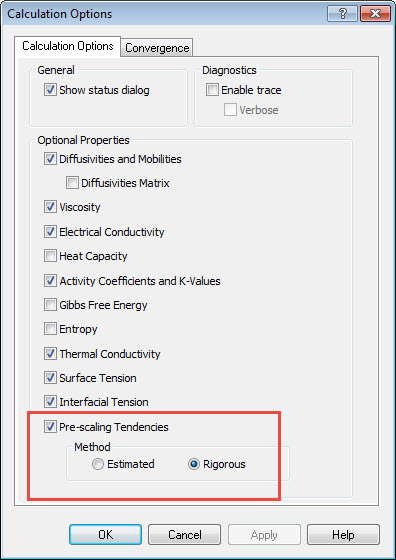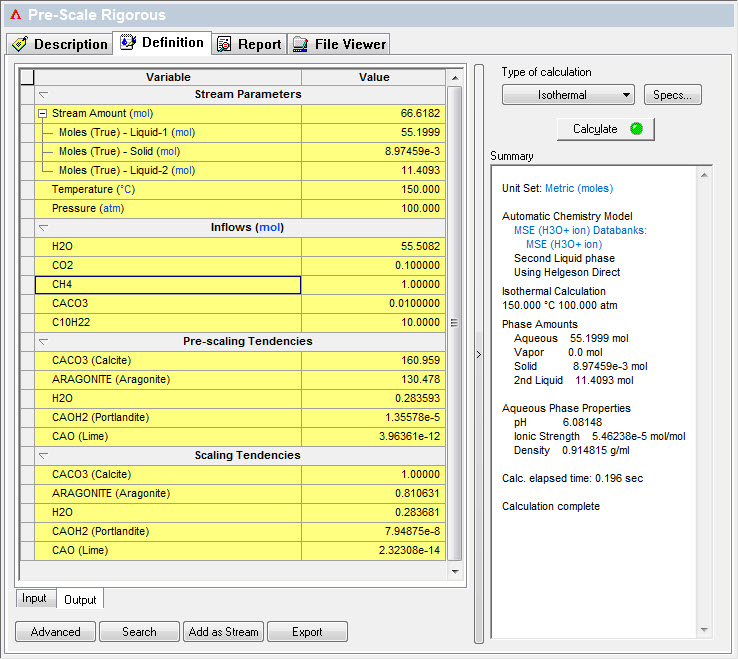Pre-scaling Tendencies
Contents
What is a Pre-scaling tendency?
OLI Defines a Pre-Scaling tendency is the scaling tendency before any solids have been formed. Many industries, notably the up-stream oil & gas industry, use the pre-scaling tendency to make design decisions about adding anti-scaling and anti-fouling agents or if the asset is as risk.
The normal convergence path for any OLI equilibrium calculation is the following:
- Perform an initial estimate of all variables in the calculation. Our equation set is a series of non-linear equations. These typically need an initial estimate to get things started.
- Take the ion activities at this point and then save them for pre-scale calculations
- Converge the equation set and test to see if there are indications of a phase change (vapor/solid/organic). This could be the addition or removal of a phase
- Adjust the mass of components to account for the change in phase
- Re-converge the equation set and test for phase changes again. If there is a change, repeat the above steps
- If no change in phases, conclude the calculation and make final calculations
- Transport properties (viscosity, electrical conductivity, etc.)
- Final values for post-scaling tendencies
- Additional thermodynamic calculations for heat capacity
- Generate the report.
Estimated Pre-Scales
The procedure described above is for Estimated Pre-scaling tendencies. The reason we consider this estimated is that we have not obtained a final convergence when the values are taken. This is usually ok since the rigorous values are usually very close in value and this method is much faster.
We have an example created in version 9.5.4 which can be found here Prescaling example (OAD, v9.5.4)
Let's look at an example.
We have created a simple case in MSE.
While not representative of a true case in the upstream oil % gas industry, it does show some of the common components.
We now need to activate the Pre-scaling calculation (different OLI programs do this step in different ways, we are using OLI Studio as an example)
Use the Specs button to find the calculation option
Check the Pre-Scaling Tendencies box and then the Estimated radio button.
We will run this case and look at the output.
Look the pre-scaling tendencies for CaCO3(Calcite). This value is 160.853 If you look at the Scaling Tendencies (this is also known as the post-scaling tendencies) the value for the same species is 1.0 which means the solid has formed. The calculation time is 0.124 seconds.
Rigorous Pre-Scales
For version 9.5.4 of the OLI Engine (which affects all the OLI software) we have added rigorous pre-scales. We added this feature because in some cases the estimated value was too far off from reality. This is especially true when you have scaling solids which have common ions such as CaCO3 and MgCO3 in the same model or with very soluble species such as Na2</sub)CO3.
The overall calculation path is similar to the previously described path but it has one major change:
- Perform an initial estimate of all variables in the calculation. Our equation set is a series of non-linear equations. These typically need an initial estimate to get things started.
- Converge the equation set and test to see if there are indications of a phase change (vapor/solid/organic). This could be the addition or removal of a phase
- Adjust the mass of components to account for the change in phase
- Re-converge the equation set and test for phase changes again. If there is a change, repeat the above steps
- If no change in phases, conclude the calculation and make final calculations
- Transport properties (viscosity, electrical conductivity, etc.)
- Final values for post-scaling tendencies
- Additional thermodynamic calculations for heat capacity
- Mathematically eliminate all solids from the calculation and repeat the convergence steps above
- When converged, store the scaling tendencies as pre-scaling tendencies.
- Generate the report.
In the past, if you wanted to have rigorous pre-scaling tendencies you had to recreate the chemistry model without any solids and then re-calculate the equation set. This manual step is now automatically done for you internally.
Here is an example, we are using the same input stream but we are activating the rigorous pre-scaling option. Use the Specs button to select Rigorous
Run the calculation
Look the pre-scaling tendencies for CaCO3(Calcite). This value is 160.959 If you look at the Scaling Tendencies (this is also known as the post-scaling tendencies) the value for the same species is 1.0 which means the solid has formed. The calculation time is 0.196 seconds.
Differences
The values for the rigorous pre-scaling tendencies are different. The differences are small in this case but in larger models the differences can be significant.
In this case The Estimated v. Rigorous pre-scaling tendency for CaCO3 is 160.853 v 160.959 which is small difference. The Estimated v. Rigorous calculation time is 0.124 seconds v. 0.196 seconds. While that doesn't seem like much, in a large calculation or flowsheet simulation, that extra 0.07 seconds can add up significantly.
